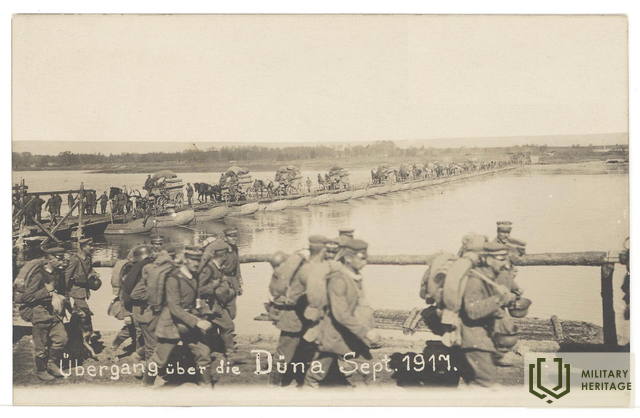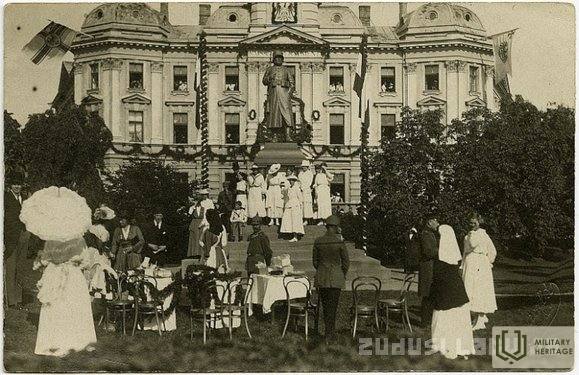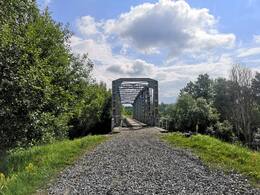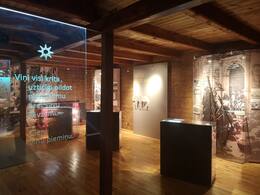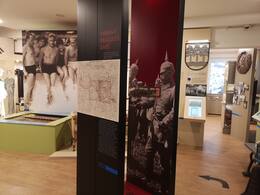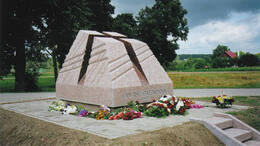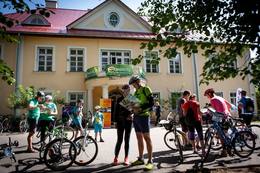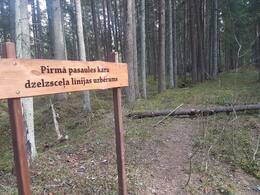Battle of Jugla - Itier offensive I WW1
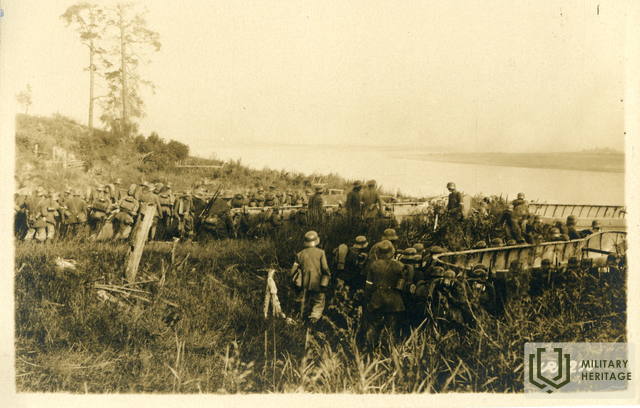
The Riga operation, also known in military history as the Battle of Riga or the Itier Riga Offensive (German: Schlacht um Riga - English: 'Battle of Riga') to occupy Riga and surround the 12th Army units of the Russian Republic defending it. After the revolution of February 1917 and the abolition of the monarchy, the combat capabilities of the Russian army decreased every month. Already at the end of the summer, according to military terminology, this army can probably be called "people's militia". The battles took place from September 1 to 6, 1917. More than 60,000 troops took part in the attack on the German side and 161,000 soldiers on the Russian side. Soldiers of the 2nd Latvian Rifle Brigade in the Defense Battle near Little Jugla were able to prevent Russian troops from entering the siege
The Commander-in-Chief of the German 8th Army, Oskar von Hutier, near Riga, wanted to test a new method of warfare when, after several hours of highly concentrated and combined artillery fire over 500 x 400 m rectangles, an immediate infantry attack followed. On the morning of September 1, 1917, after a three-hour artillery fire, the Germans began building wooden pontoon bridges over the Daugava. Approximately 560,000 rounds were fired from 1,159 cannons and mortars, which completely suppressed 66 Russian cannons and forced the retreat of the 186th division on the right bank of the Daugava.
After the artillery fire, an attack on the positions of Latvian riflemen began in the middle of September 2. The defensive battles took place on the 14 km long front along the right bank of the Little Jugla. Before the battle at the Little Jugla River, the Latvian Rifle Brigade had not previously carried out any joint combat operations, sometimes two regiments operated together in one operative group. In the summer of 1917, the brigade received additions or routes from the Latvian Rifle Reserve Regiment, which was stationed in Valmiera district. Before the Battle of the Little Jugla II Brigade for three months, from 15.05.1917. until 21.08., were in positions in the highway area of Ložmetējkalns and Kalnciems. No fighting took place during this period, but prolonged ditches, food and other problems tired the soldiers.
Soldiers of the 2nd Latvian Rifle Brigade with some cannons confronted a numerically and technically stronger group of German troops, which also used aviation, fire throwers and cannon-filled cannon grenades in the attack. The riflemen managed to hold the front heroically for 26 hours until September 3, when the main forces of the 12th Russian Army had already been withdrawn from Riga on the Riga-Petrograd railway. Having fulfilled their mission, the surviving Latvian soldiers resigned to the positions of Sigulda and Cēsis by order of the 12th Army Command. The losses were very severe - the 5th Zemgale and 6th Tukums Latvian Rifle Regiments knocked out more than half of the fighters, the 7th Bauska and 8th Valmiera Latvian Rifle Regiments suffered less.
More information sources
https://lv.wikipedia.org/wiki/R%C4%ABgas_oper%C4%81cija#cite_note-autogenerated1-1
http://latviesustrelniekusaraksts.lv/Kaujas_darbiba/Book_3.html
Related timeline
Related objects
River trenches
The first leg of the route is in the center of the River Valley at the bus stop.
On the morning of September 1, 1917, after a three-hour artillery fire, the Germans began construction of three wooden pontoon bridges over the Daugava near Ikšķile. Approximately 560,000 rounds were fired from 1,159 cannons and mortars, which completely suppressed 66 Russian cannons and forced the retreat of the 186th division on the right bank of the Daugava. The commander of the 12th Russian Army, General Parskis, ordered the 43rd Corps to carry out a counterattack at the break and handed over to the Commander of the Corps the 33rd, 136th, 138th Division, 116th Division and 2rd Latvian Rifle Brigade.
On the afternoon of September 1, Latvian riflemen were ordered to fight against the Germans crossing the Daugava. The 2nd Latvian Rifle Brigade from Ropaži went towards the attacking German units and the soldiers of the 5th Zemgale Latvian Rifle Regiment reached the fortified positions along the right bank of the Little Jugla River around four in the afternoon. After the artillery fire, an attack on the positions of Latvian riflemen began in the middle of September 2. The defensive battles took place on the 14 km long front along the right bank of the Little Jugla. Soldiers of the 2nd Latvian Rifle Brigade with a few cannons opposed a numerically and technically stronger group of German troops, who also used aviation, fire throwers and cannon-filled cannon grenades in the attack. The riflemen managed to hold the front heroically for 26 hours until September 3. Having fulfilled their mission, the surviving Latvian soldiers resigned to the positions of Sigulda and Cēsis by order of the 12th Army Command. The losses were very severe - the 5th Zemgale and 6th Tukums Latvian Rifle Regiments knocked out more than half of the fighters, the 7th Bauska and 8th Valmiera Latvian Rifle Regiments suffered less.
Cultural Heritage Centre "Tīnūži Manor"
The Cultural Heritage Centre ‘Tīnūži Manor’ is located in Ogre municipality, Tīnūži village, 7 km from the cities of Ogre and Ikšķile. The first written evidence about the manor dates back to the 16th century. Until the mid-18th century it was considered an economic production unit with small and insignificant buildings. But over time it grew into a large farm. During World War I, battles between the Russian and German armies took place here, and the Latvian Riflemen were also involved. During the War of Independence Tīnūži manor was used as the headquarters and armoured car park of the 1st Valmiera Infantry Regiment of the Latvian Army. In 1932, the manor was given to the Union of the Latvian War Invalids, which provided accommodation and care for war veterans. During World War II (in 1943) the German Army unit FAT 212 was transferred from Estonia to Tīnūži manor. It was a saboteur unit that prepared soldiers to fight the Red Army. Latvian soldiers were also trained in the arts of intelligence gathering, guerrilla warfare tactics and sabotage. The lord house of Tīnūži manor was destroyed when the Red Army was moving towards Riga. Nowadays it is a place with a beautiful landscape and historical buildings on the banks of the Little Jugla River. Exhibits dedicated to historical events, including the ones concerning the Latvian Riflemen, can be seen at the Cultural Heritage Centre ‘Tīnūži manor’.
Ogre History and Art Museum
Ogre History and Art Museum was established in 1981. The museum collection comprises more than 40 thousand different units obtained in the territory of Ogre city and the former Ogre district. It extensively depicts the cultural and historical heritage starting from ancient times till modern days.
In the exhibition “From Bank to Museum” the visitors can get acquainted with the history of the building at 36 Brīvības street, and its transformation over the period of 50 years. Initially built as a bank of the USSR, it has lately become the home of Ogre History and Art Museum.
The exposition “Holiday-Makers in Ogre” is dedicated to one of the brightest and most legendary pages in the history of the town. It shows the recreation possibilities, the entertainments of the holiday-makers’, as well as the legends entwining the cultural and social life of Ogre from the beginning of the 20 th century till World War II. The life story of Ogre as a resort town is presented by carefully selected documents and objects, as well as their attractive artistic presentation.
Exhibitions at the museum change monthly. The thematic exhibitions are usually dedicated to different historical events but the artists, such as painters, ceramists, graphic designers, photographers and representatives of other creative professions from Ogre Municipality and the whole country, are represented in the art exhibitions.
Monument to the Battle of the Mazā Jugla at Tīnūži
Located in Ikšķile region, Tīnūžu village, by the highway near Tīnūži primary school.
A memorial to Latvian riflemen who fought against the German army during World War I. The battle of the Little Jugla River on September 1-2, 1917 was the culmination of the Riga operation. The German army launched an attack on Ikšķile with the aim of capturing Riga and capturing the 12th Russian army. German army units, crossing the Daugava via pontoon bridges, reached the vicinity of the Little Jugla River, where they were blocked by Latvian riflemen. They were ordered to delay the adversary until the entire Russian 12th Army left the siege without being captured by the German army. The fighting is taking a heavy toll on both warring parties.
Today you can see the monument to the sculptor Jānis Karlovs, "The Altar of Heroes", which was unveiled in 2005 and will be dedicated to Latvian fighters. Tīnūži Manor, where the exposition is located, is 300 meters away.
Mercendarbe Manor
Located in Baldones county, 4 km from Baldones, near the highway Iecava – Baldone – Daugmale.
Mercendarbe is one of the manors, not far from which was the Baldones resort, which was the oldest in the territory of Latvia. The history of the manor is complemented by the events of the 1st World War. It was located 7 km away from the active battlefield - Death Island. Mercendarbe manor served the purposes of the German army, and its surroundings became a direct witness to the war.
During the war, railway infrastructure was one of the most important issues in the plans of every army. In 1915, Germany had occupied the territory of Latvia (then part of Russia) and started building new railway lines to quickly transport soldiers, organize supplies and export resources to Germany, such as timber loads. One of the new railway lines connected Mercendarbi with Vecumnieki and further with Jelgava, which was an important place of support for the German army. The mercenary line was used to supply soldiers on Death Island, and it also provided German army units when they attacked Riga, forcing the Daugava.
Today, the manor houses the Baldones Museum and the Tourist Information Point. A Mercendarbe walking trail has been created, which is part of the "Baldone Story Trail". The German army railway embankment can still be seen.
Section of the German military railway on the route Mercendarbe-Skarbe
The former railway route is clearly visible in nature, as the railway embankment has been preserved for practically the entire section of the road, where there is a forest today. When walking along the embankment, pay attention to the ground cover - it is possible to see preserved sleeping places. Today, some of the railway sections serve as the base of roads, for example as a logging road. Near the Mercendarbe manor, the railway embankment has been leveled, but near Riekstukalnas, where the forest resumes, it continues.
O. Anderson, a researcher of the history of Baldone, writes about the history of the given railway as follows:
"1. During the World War, when in 1916 the front line had stabilized along the left bank of the Daugava to supply the German army, the commander of the army railway service made a decision on March 15, 1916 to build a line from Vecumnieki to Mencendarbi. The length of the line was 25 kilometers. On March 30, 5,000 workers started work, and on May 1 the line was built to Skarbe station, and on May 6 to Mercendarbe. The railway started in Vecumnieki, as the station Neugut Kurland, then the stations Nougut Nord, Birsemniek, Gedeng, Skarbe, Merzendorf (names in German). Later, the line was extended to Rieksti hill and to Vilku hill opposite Ikškilei. Since the Jelgava-Krustpils line had already been rebuilt to the German (Western European) gauge, a line with a gauge of 1435 mm also ran to Mercendarbi. It was not some kind of "banitis", but a normal railway. The biggest station was Skarbe. The biggest cargo transshipment works took place there, in order to further transport them to the front by horse transport. The railway line was still in operation in 1921, when logs and firewood were sent along it. Demolished in 1925. Nowadays, the site of the station has been preserved intact, the railway track, track embankment, sleeping places are visible. It's amazing that after 100 years we can walk on this railway. It's just that at times it seems that a train is coming and you'll have to step aside."
Related stories
Battle at the Little Jugla River / Riga operation
The narrator describes his impressions of the beginning of the Riga operation, when the artillery of the German army starts firing on the positions of the Russian army. Describes the chaos that stands out in the Russian army and the mood of Latvian riflemen before the battles.





